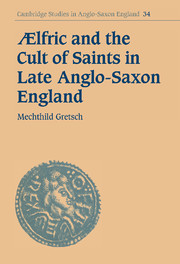Book contents
- Frontmatter
- Contents
- Preface
- List of abbreviations
- 1 Ælfric's sanctorale and the Benedictional of Æthelwold
- 2 Gregory: the apostle of the English
- 3 Cuthbert: from Northumbrian saint to saint of all England
- 4 Benedict: father of monks – and what else?
- 5 Swithun and Æthelthryth: two saints ‘of our days’
- 6 Epilogue
- Bibliography
- Index of manuscripts
- General index
5 - Swithun and Æthelthryth: two saints ‘of our days’
Published online by Cambridge University Press: 22 September 2009
- Frontmatter
- Contents
- Preface
- List of abbreviations
- 1 Ælfric's sanctorale and the Benedictional of Æthelwold
- 2 Gregory: the apostle of the English
- 3 Cuthbert: from Northumbrian saint to saint of all England
- 4 Benedict: father of monks – and what else?
- 5 Swithun and Æthelthryth: two saints ‘of our days’
- 6 Epilogue
- Bibliography
- Index of manuscripts
- General index
Summary
With this chapter we enter a different work: the Lives of Saints. Do we also enter a different world, that is, an intellectual, spiritual or narratological ambience that is tangibly distinguished from the one prevailing in the Catholic Homilies? What may be deduced about the Lives of Saints in contradistinction to the Catholic Homilies – their date, their subject matter and manner of discourse, their aims – is based on the sparse remarks by Ælfric himself in his various prefaces to both works.
THE TWO COLLECTIONS
From these prefaces it is clear that Ælfric intended the two works as a sequence: the two volumes of Catholic Homilies (each containing forty pieces) were to be followed by at least one volume of Lives of Saints (again approximately forty pieces). It is possible, but not provable, that at one point Ælfric had in mind composing a second volume of saints' Lives in order to match entirely the two series of Catholic Homilies. The composition of the Lives of Saints can be assigned to the years c. 994 × c. 998, that is, after the completion of the Second Series of Catholic Homilies, and before the death of Æthelweard, ealdorman of the western provinces, to whom the Lives of Saints are dedicated (and who, in both their prefaces, is referred to as alive).
- Type
- Chapter
- Information
- Aelfric and the Cult of Saints in Late Anglo-Saxon England , pp. 157 - 231Publisher: Cambridge University PressPrint publication year: 2006

